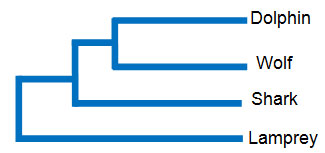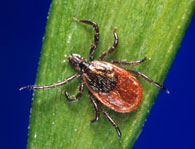
Based on the similarities and differences presented in this chart, which of the statements below is true?
|
Organism
|
Fur Texture
|
External Ear
|
Hole in skull for
whisker nerves |
| Sea Lion |
Thick
|
Yes
|
Large
|
| Bear |
Thick
|
Yes
|
Small
|
| Walrus |
Thin
|
No
|
Large
|
| Seal |
Thin
|
No
|
Large
|
A. Bears are most closely related to walruses.
Incorrect. Bears and walruses do not share any common characteristics.
B. Seals and sea lions are the most closely related to each other.
Incorrect. Seals and sea lions only share 1/3 of their characteristics.
C. Bears are more closely related to seals than to sea lions.
Incorrect. Bears and seals have do not share any common characteristics, while bears and sea lions only share 2/3 of their characteristics.
D. Walruses and sea lions are closely related.
Correct! Walruses and seals share all of their main characteristics.
Which interpretation of this family tree is correct?

A. Dolphins are more closely related to sharks than to wolves.
Incorrect. Dolphins and wolves are the most closely related according to the chart.
B. Dolphins are more closely related to wolves than to sharks.
Correct! When looking at the top of the tree, dolphins and wolves share a relatively recent common ancestor.
C. Sharks evolved from lampreys.
Incorrect. The family tree only shows that lampreys share an ancient common ancestor with sharks, wolves, and dolphins.
D. Dolphins are more highly evolved than wolves.
Incorrect. The family tree shows that dolphins and wolves share common traits and have a common ancestor. The family tree could also have shown wolves at the top and dolphins underneath.
Examine the chart below. According to the evidence presented, tunicates are most closely related to —
| Organism |
Brain
|
Notochord
|
Gill Arches
|
Blood
|
Arms & Legs
|
| Human |
Yes
|
Yes
|
Yes
|
Yes
|
Yes
|
| Sea Slug |
Yes
|
No
|
No
|
Yes
|
No
|
| Tunicate |
Yes
|
Yes
|
Yes
|
Yes
|
No
|
| Sponge |
No
|
No
|
No
|
No
|
No
|
| Choanoflagellate |
No
|
No
|
No
|
No
|
No
|
A. humans
Correct! Both tunicates and humans have a brain, gill arches, blood, and a notochord.
B. sponges
Incorrect. Although tunicates and sponges look similar, they do not have other key characteristics in common.
C. choanoflagellates
Incorrect. According to the chart, tunicates and choanoflagellate have no characteristics in common.
D. sea slugs
Incorrect. Tunicates and sea slugs have only two characteristics in common.
Use the key below to identify the following organisms.

| 1 | a. Arachnid has a tail or a stinger | go to #2 |
| b. Arachnid has no tail or stinger | go to #3 | |
| 2 | a. Tail is straight like a needle | Order Uropygi |
| b. Tail curves with a stinger at the tip | Order Scorpiones | |
| 3 | a. Has enlarged pedipalps (claws) | go to #4 |
| b. Lacks pedipalps (claws) | go to #5 | |
| 4 | a. Less than 5mm long and flat | Order Pseudoscorpiones |
| b. 8 to 51mm long and spider-like | Order Amblypygi | |
| 5 | a. Arachnid has regular legs | go to #6 |
| b. Arachnid legs are thin/stilt-like with "high" knees and body low to the ground | Order Opiliones | |
| 6 | a. Body is separated into a cephalothorax and abdomen (i.e. has a waist) | go to #7 |
| b. Body is oval-shaped and lacks a waist | Order Acari | |
| 7 | a. Has 7 segments on each leg and 1st pair of legs are not longer than the rest | Order Araneae |
| b. Has some other number of segments on each leg and 1st pair of legs are longer than the rest | Order Solifugae |
A. Order Scorpiones
Incorrect. This arachnid does not have a stinger. After step one, you should have gone to step three.
B. Order Pseudoscorpiones
Incorrect. This arachnid does not have claws. After step three, you should have gone to step five.
C. Order Acari
Correct! The organism is a tick, which is the order Acari. Ticks have no stingers, have regular legs and an oval-shaped body, and lack pedipalps.
D. Order Opiliones
Incorrect. This arachnid has regular legs. After step five, you should have gone to step six.